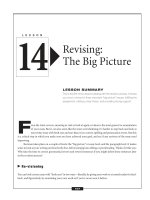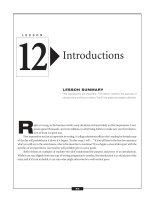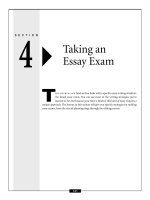Write Better Essays - Revising - The Big Picture
Bạn đang xem bản rút gọn của tài liệu. Xem và tải ngay bản đầy đủ của tài liệu tại đây (114.64 KB, 14 trang )
F
rom the Latin revisere, meaning to visit or look at again, revision is the most general re-examination
of your essay. But it can also seem like the most overwhelming; it’s harder to step back and look at
your entire essay with fresh eyes and ears than it is to correct spelling and punctuation errors. But this
is a critical step in which you make sure you have achieved your goal, and see if any sections of the essay need
improving.
Revision takes place on a couple of levels: the “big picture” or essay level, and the paragraph level. It makes
sense to look at your writing on these levels first, before jumpig into editing or proofreading. Think of it this way:
Why take the time to correct grammatical errors and reword sentences if you might delete those sentences later
in the revision process?
Re-visioning
You can look at your essay with “fresh eyes” in two ways—literally, by giving your work to a trusted reader for feed-
back, and figuratively, by examining your own work as if you’ve never seen it before.
LESSON
Revising:
The Big Picture
LESSON SUMMARY
This is the first of two lessons dealing with the revision process. It shows
you how to revise for three important “big picture” issues: fulfilling the
assignment, stating a clear thesis, and providing strong support.
14
107
If you think professional writers work alone, think again. They know how important it is to get feedback
before they send their work to the publisher—it’s not uncommon for them to share their work with a number of
trusted readers first. That strategy is important for your essays, too. Readers can help you pinpoint the strengths
and weaknesses of your writing. They can tell you what works well, and what doesn’t; what comes across clearly
to them, and what confuses them.
When you share your writing with people you trust to give you honest feedback, ask them:
■
What do you like about my essay?
■
Is there anything that seems confusing or unclear?
■
What do you think my purpose was in writing this essay?
■
Is there anything you need to know more about, or that needs more explanation?
■
What do you think I could do to improve this essay?
These questions can also work when you direct them to yourself. But before you reread for revising, take a
break. The best revisions take place a day or two after you’ve completed your draft. That time lets you approach
your work with the “fresh eyes” we mentioned earlier in this lesson.
Try reading your essay aloud. Read as if you are presenting it to an audience, and listen to your words. This
technique can help you find places where your wording sounds awkward, or where your sentences are confusing
or too long. You can also hear where your writing simply doesn’t convey what you intended it to. Mark those areas
that sound as if they should be revised, making notes of ideas for how to improve them. Remember to keep in mind
the following:
■
Does my essay fulfill the assignment?
■
Is my thesis statement clear? Is it easily identifiable?
■
Are my ideas well supported with examples, evidence, and details?
Reworking
Once you’ve got feedback and have taken your own notes on what could be improved, it’s time to make changes.
Those changes could be additions, deletions, or rewordings. The second type of change is probably the hardest.
Especially if you don’t consider yourself a strong writer, you may feel unwilling to give up a paragraph, or even a
sentence. But revising is about keeping what works, and fixing or eliminating what doesn’t. If it doesn’t work, it
detracts from the rest of your essay and needs to go.
Fulfilling the Assignment
On the largest scale, if your draft doesn’t fulfill the requirements of the assignment, you need to figure out where
you went wrong. You probably don’t need to rewrite the whole thing, but rather shift the focus. Try rewriting the
assignment in your own words to determine exactly what is expected of you. You may simply need to add a few
sentences to your introduction and conclusion, or add a new paragraph that helps clarify your position. Don’t stop
reworking until your essay clearly and completely responds to the assignment.
–REVISING: THE BIG PICTURE–
108
Rewording Your Thesis
If your thesis isn’t clear, or is not easily identifiable, you probably have one of these common problems:
■
No thesis. Your essay may have a lot to say, but its paragraphs are not held together by one controlling idea.
This type of essay is often the result of insufficient planning. If you took the time to consider your audience
and purpose, brainstorm, and develop a tentative thesis and outline, you should be able to avoid this prob-
lem. Go back to your prewriting notes to find the main idea you started with, and begin drafting a thesis
from there.
■
Your thesis isn’t supported by your essay. You do have a thesis, but the body of your essay supports another
(perhaps similar) idea. This often happens when writers discover, through the drafting process, that they feel
differently about their topic than they originally thought. As a result, they end up building a case for a differ-
ent thesis. If your essay does indeed support an idea that’s different from your thesis (and that idea still
addresses the assignment), the easiest way to correct the problem is to rewrite your thesis to fit your essay.
■
More than one main idea. If your essay has two, or even three, main ideas, you may not have sufficiently
narrowed your thesis during the planning stage. Recall in Lesson 5 the discussion concerning the need to
have a thesis that correlates with the space confines of an essay. It must be broad enough to warrant an essay-
length discussion, and narrow enough to be able to complete a thorough discussion within those confines.
Or, you may have discovered other interesting ideas while drafting and decided to include them. As a result,
you have two or three underdeveloped mini essays rather than one fully developed idea. If you have more
than one main idea, see if there is a way to tie them together. Otherwise, choose the better of the two and
revise your essay to develop that idea alone.
Checking for Support
You’ll also need to assess how well your draft supports your thesis, and how well your evidence, examples, and details
support the ideas you put forth. Types of support include:
■
specific examples
■
facts
■
reasons
■
descriptions and anecdotes
■
expert opinions and analysis
■
quotations from the text
How Much Is Enough?
There is no hard and fast rule about how much support you need for an effective essay. But it’s safe to say that one
supporting idea is almost never enough. Two is better, but it may not be enough to make your claim. Three is often
the magic number—it has “critical mass,” and it shows readers why you think what you do. Four ideas are even
better; beyond critical mass, they’re a good solid amount of evidence.
–REVISING: THE BIG PICTURE–
109
Support That’s Directly Related to the Thesis
As important as the amount of support is its relevance to the thesis. What good are ten supporting paragraphs if
they’re not supporting the right idea? Read the following essay carefully, paying particular attention to the sup-
port provided for the thesis.
When was the last time you told a lie? If you’re like most people, it was probably recently. Did you know that you can
also lie without even saying a word? This kind of lie can be even more devastating.
The poet Adrienne Rich said, “Lying is done with words and also with silence.” To lie means “to tell something
that is untrue.” But it also means “to be deceptive.” We often use silence to deceive. Rich is right. We lie with words, but
also with silence.
For example, a man buys a necklace for his girlfriend from a thief. He knows the necklace is stolen and doesn’t
tell his girlfriend. As a result, she finds out it’s a stolen necklace when she tries to take the necklace back to the store for
repairs.
I’m guilty, too. I knew my friend’s boyfriend was seeing someone else. But I kept quiet. I helped keep her in the
dark. Then, when she found him out—and found out that I’d known about it—it was terrible. It destroyed their rela-
tionship and our friendship.
Looking closely at the two supporting examples, you can see that neither example addresses how these silent
lies are more devastating than a spoken lie. Now the writer must make a decision. Should she expand each para-
graph to explain how keeping silent was worse than lying aloud? Or should she revise her thesis to eliminate the
idea that silent lies are “more devastating” than regular lies?
Choosing the latter, she revised her thesis once more and created the following thesis statement:
We lie with words, but also with silence. And these lies can be equally devastating.
Now the writer has two solid supporting examples for her thesis. But she should probably add as least one,
and preferably two more, to strengthen her essay.
Practice 1
So far, there are only two supporting paragraphs for the lying with silence draft. Add an additional supporting para-
graph to strengthen and support this essay.
–REVISING: THE BIG PICTURE–
110
Strategies for Convincing
While this essay now has a clear, focused thesis supported by several examples, it still lacks persuasive power. Before
you consider your check for support complete, consider whether you’ve applied the strategies for convincing dis-
cussed in Lesson 10. Ask the following questions:
■
Are your supporting paragraphs specific?
■
Do you have any unsupported statements?
■
Have you established credibility?
■
Do you acknowledge counterarguments?
■
Do you make concessions?
■
Do you avoid absolutes?
■
Do you say anything that might offend your audience?
The examples in the lying with silence essay are not as specific as they could be. In fact, they would work better if
they were expanded with more information that would show how people are affected by these silent lies. Instead
of one paragraph for each example, two or even three would bring the examples to life and make them more spe-
cific. Because the essay relies almost entirely on examples for support, the more detailed those examples are, the
more convincing they will be.
Practice 2
On a separate sheet of paper or on your computer, revise one of the example paragraphs in the lying with silence
essay to provide more information and specific details. Expand the example until you have two complete
paragraphs.
In Short
Revision deals with the content and style of the essay and should begin by addressing the big-picture issues: the-
sis and support. Look at your essay with fresh eyes, both literally in the form of trusted readers, and figuratively,
as you reread after taking a break from your writing. Then, rework the essay to assure that it fulfills the assign-
ment, contains a strong, clear thesis statement, and is supported with convincing examples and evidence.
–REVISING: THE BIG PICTURE–
111
Use the read-aloud technique for another essay you’re working on or that you wrote for another
purpose. What did you notice about your writing? Do you like the way it sounds? Does it convey the
meaning(s) you intended?
Skill Building until Next Time









